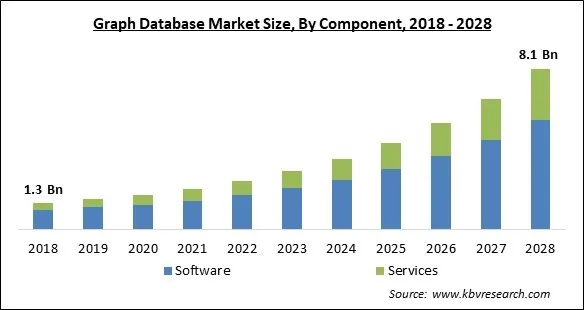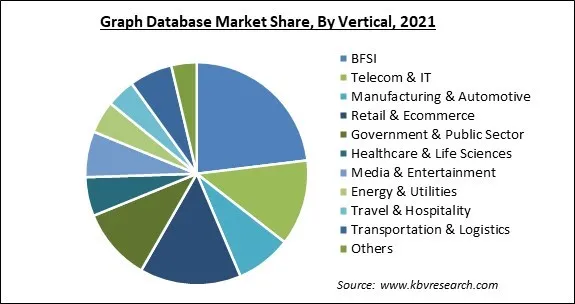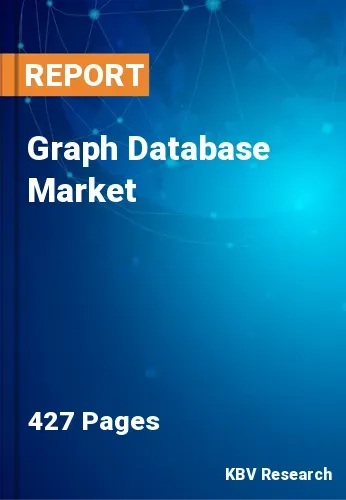The Global Graph Database Market size is expected to reach $8.1 billion by 2028, rising at a Market growth of 22.2% CAGR during the forecast period.
A graph database is a single-purpose, specialized platform for building and manipulating graphs. Another often used word for a graph database is graph analytics, which refers to the process of analyzing data in a graph style with data points acting as relationships and nodes acting as edges. A database that can serve graph formats is required for graph analytics. It can be a specialized graph database or a convergent database that supports several data types, including graphs.
Additionally, a graph database is a database that represents and stores data using graph layouts for semantic queries with edges, nodes, and properties. The graph is an important notion in the system (or relationship or edge). In addition, the graph connects the store's data items to a set of edges and nodes, with the edges indicating the nodes' relationships. The relationship enables data in the storage to be immediately connected and, in many circumstances, retrieved in a single operation. The connections between data are prioritized in graph databases. Because relationships are preserved in the database indefinitely, querying them is easy. Graph databases can easily depict connections and make them helpful for material that is extremely interconnected.
Graph databases are often referred to as NoSQL databases. Graph databases are identical to conventional network model databases and also represent general graphs, however, network-model databases function at a low level of abstraction and dearth of straightforward traversal through a chain of edges. Graph databases have a variety of storing mechanisms. In a graph database, relationships are first-class citizens that can be directed, labeled, and given properties. Several graph databases rely on a SQL engine and use a table to store the graph data. Others store data in a key-value store or a document-oriented database, making them fundamentally NoSQL. However, a table is a logical element, which adds another layer of abstraction among the graph database management system, the graph database, and the physical devices on which the data is stored.

The COVID-19 outbreak caused a significant downfall to various economies all over the world. The outbreak of the novel coronavirus slowed down numerous businesses globally. In addition, due to the rapid spread of the infection, governments all over the world were forced to impose countrywide lockdowns. Due to the travel restrictions under the lockdown, the supply chain of various goods, as well as intermediate goods, was significantly disrupted. Moreover, the lockdown also caused a considerable hindrance to various manufacturing facilities worldwide. In addition, the COVID–19 outbreak exposed flaws in business models throughout various verticals, it also provided various chances for businesses to expand and digitalize beyond geographies as the use and incorporation of technologies like cloud, analytics, AI, IoT, and blockchain surged throughout the lockdown time.
Graph database services and tools are widely being utilized all over the world, to the extent that several legacy database providers are attempting to integrate graph database schemas into their prevailing relational database infrastructures. While the strategy might appear to save money in theory, it might actually slow down and degrade the performance of queries run against the database. A graph database is changing traditional brick-and-mortar businesses into digital business powerhouses in terms of digital business activities. Companies face issues when it comes to storing large amounts of connected data in the database that isn't appropriate for the task at hand.
Knowledge networks must have datasets, methods, and documentation to ensure accessibility across applications, support knowledge-intensive applications, and interlink numerous disciplines to create a cross-domain knowledge network. Biometrics, home environment, patient health history, and real-time behavior are all required for applications such as senior patient care and monitoring. In addition to a personalized knowledge graph for healthcare, knowledge networks can interconnect multimodal cross-domain data and information collected from several sources. Certain knowledge graphs in this information network are still proprietary, and use by universities or researchers is usually prohibitively expensive.
While graph databases, technically, are NoSQL databases, they must run on a single server in practice because they cannot be distributed across a low-cost cluster. This is what causes a network's performance to rapidly deteriorate. Another potential disadvantage is that developers must write their queries in Java because there is no SQL to retrieve data from graph databases, necessitating the hiring of expensive programmers. Alternatively, developers can use SparcQL or one of the other query languages developed in order to support graph databases, but this would necessitate learning a new skill. As a result, graph database systems suffer from a lack of standardization and programming ease. There are visualization tools for graph databases, although they are still in the early stages of development.

Based on Type, the Market is segmented into Labeled Property Graph and Resource Description Framework. In 2021, the Resource Description Framework segment procured a substantial revenue share of the graph database Market . Each update of information is represented by a distinct node in an RDF graph model. In an RDF model, the user must create a separate node that connects to the real person node. An RDF graph model, in particular, is made up of arcs and nodes. A node for the object, a node for the subject, and an arc for the predicate represent an RDF graph notation or a statement. A node can be left blank, be literal, or have a URI associated with it. A URI can also be used to identify an arc. There are two types of literal for nodes viz. plain, or untyped, and typed. A lexical form and, if desired, a language tag is included in a simple literal. A typed literal is a string that contains a URI that defines a certain datatype. When the data does not have a URI, a blank node can be used to appropriately depict the status of the data.
Based on Vertical, the Market is segmented into BFSI, Telecom & IT, Manufacturing & Automotive, Retail & Ecommerce, Government & Public Sector, Healthcare & Life Sciences, Media & Entertainment, Energy & Utilities, Travel & Hospitality, Transportation & Logistics, and Others. In 2021, the BFSI segment procured the largest revenue share of the graph database Market . The rising growth of this segment is owing to the increasing investments and efforts by various banks to bring digitalization in their processes. Graph database solutions allow executives to effectively respond to their workloads in order to provide enhanced customer experiences. Hence, this factor is accelerating the growth of this segment.
Based on Component, the Market is segmented into Software and Services. In 2021, the services segment garnered a substantial revenue share of the graph database Market . These services are critical for the operation of graph database solutions and ensuring a quicker and more efficient implementation that maximizes the value of company investments. Services connected with this type of software are a crucial part of the Market , ensuring that graph database solutions are effectively used. The demand for these services is increasing due to a surge in end-user adoption of services, as they assure the smooth operation of the software as well as platforms all through the process.
Based on Deployment Type, the Market is segmented into On-premise and Cloud. In 2021, the on-premise segment procured the largest revenue share of the graph database Market . The growth of this segment is owing to the rising utilization of company-owned devices due to the fact that a dedicated system for the management of graph database solutions on the premises of the company is more reliable in contrast to the cloud-based deployment of these solutions.
Based on Organization Size, the Market is segmented into Large Enterprises, and Small & Medium Enterprises. In 2021, the Small & Medium Enterprises segment witnessed a significant revenue share of the graph database Market . The increasing growth of the segment is due to the fact that cloud-based solutions along with services assist SMEs in improving their business performance and efficiency. In addition, small and medium organizations also adopt novel and advanced technologies in order to accelerate their growth. Hence, the growth of this segment would augment in the coming years.
Based on Application, the Market is segmented into Fraud Detection & Prevention, Risk, Compliance & Reporting Management, Supply Chain Management, Operations Management & Asset Management, Knowledge Management, Content Management, Data Extraction & Search, Customer Analytics & Recommendation Engines, Infrastructure Management, IoT, Industry 4.0, Scientific Data Management, Metadata & Master Data Management, and Others. In 2021, the fraud detection & prevention segment witnessed the largest revenue share of the graph database Market . The growth of the segment is surging due to increasing adoption of graph databases across organizations as a fraud detection tool to protect consumer data, manage risk, and offer the most value to shareholders. One of the most popular tools for detecting fraud, uncovering fraud rings, and identifying sophisticated scams, such as corruption, eCommerce fraud, and money laundering, is the graph database. In addition, Graph databases are used to uncover fraud from huge volumes of data in money laundering and financial crime. They use pattern recognition, categorization, statistical analysis, and machine learning models.
| Report Attribute | Details |
|---|---|
| Market size value in 2021 | USD 2 Billion |
| Market size forecast in 2028 | USD 8.1 Billion |
| Base Year | 2021 |
| Historical Period | 2018 to 2020 |
| Forecast Period | 2022 to 2028 |
| Revenue Growth Rate | CAGR of 22.2% from 2022 to 2028 |
| Number of Pages | 427 |
| Number of Tables | 709 |
| Report coverage | Market Trends, Revenue Estimation and Forecast, Segmentation Analysis, Regional and Country Breakdown, Companies Strategic Developments, Company Profiling |
| Segments covered | Type, Component, Deployment Type, Organization Size, Application, Vertical, Region |
| Country scope | US, Canada, Mexico, Germany, UK, France, Russia, Spain, Italy, China, Japan, India, South Korea, Singapore, Malaysia, Brazil, Argentina, UAE, Saudi Arabia, South Africa, Nigeria |
| Growth Drivers |
|
| Restraints |
|
Based on Regions, the Market is segmented into North America, Europe, Asia Pacific, and Latin America, Middle East & Africa. In 2021, North America accounted for the largest revenue share of the graph database Market . Graph database tools along with associated technologies are becoming increasingly popular across North America because enterprises in this region rely heavily on data. Additionally, the advent of technology-based businesses and sectors in this region has offered considerable growth potential for graph database providers. The rising technological improvements in the region are key factors encouraging the growth of the graph database Market in North America. Market growth is also estimated to be aided by the rising number of regional Market players in the graph database sector.
Free Valuable Insights: Global Graph Database Market size to reach USD 8.1 Billion by 2028
The Market research report covers the analysis of key stake holders of the Market . Key companies profiled in the report include IBM Corporation, Oracle Corporation, Microsoft Corporation, Amazon Web Services, Inc. (Amazon.com, Inc.), SAP SE, Teradata Corporation, Hewlett Packard Enterprise Company, MarkLogic Corporation, TigerGraph, and OpenLink Software, Inc.
By Type
By Vertical
By Component
By Deployment Type
By Organization Size
By Application
By Geography


The graph database market size is projected to reach USD 8.1 billion by 2028.
The advent of open knowledge networks are driving the market in coming years, however, complex programming and standardization growth of the market.The advent of open knowledge networks are driving the market in coming years, however, complex programming and standardization growth of the market.
IBM Corporation, Oracle Corporation, Microsoft Corporation, Amazon Web Services, Inc. (Amazon.com, Inc.), SAP SE, Teradata Corporation, Hewlett Packard Enterprise Company, MarkLogic Corporation, TigerGraph, and OpenLink Software, Inc.
Yes, COVID–19 outbreak exposed flaws in business models throughout various verticals, it also provided various chances for businesses to expand and digitalize beyond geographies.
The Labeled Property Graph segment dominated the Global Graph Database Market by Type in 2021; thereby, achieving a Market value of $5.6 billion by 2028.
The North America is the fastest growing region in the Global Graph Database Market by Region in 2021, and would continue to be a dominant Market till 2028.
Our team of dedicated experts can provide you with attractive expansion opportunities for your business.

